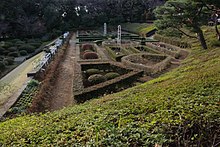Furukawa garden
The Furukawa Garden ( Japanese 旧 古河 庭園 , Kyū Furukawa teien ) in Tokyo's Kita district belongs to the villa of Furukawa Toranosuke ( 古河 虎 之 助 ) (1883–1940) from 1917.
background
The property, located in the north of Tokyo on the old Iwatsuki Kaidō road, originally belonged to Count Mutsu Munemitsu . The founder of Furukawa Zaibatsu , Furukawa Ichibē (1832-1903), adopted his second son as his successor and took over the property. When this adopted son died early, it finally fell to Toranosuke (1887–1940), a biological son of Ichibēs, who took over the property and had it redesigned.
The garden
In 1917 the western style villa was completed. The garden next to the house was also laid out to the west with lawns, flower beds and boxwood edging. The larger, lower part, however, was designed in Japanese with the help of Ogawa Jihei (1860–1933), a garden designer from Kyoto. The center of the Japanese garden is a large pond surrounded by trees. The pond has the classic shape of the "heart symbol", as it appears from 心 painted in one go . There is a “dry waterfall” ( kare-san-sui no taki ), a “yukimi” stone lantern on whose broad roof snow can be deposited, an open pavilion ( azumaya ) to relax and other things.
The Villa
The villa was one of the last works that architect Josiah Conder executed. The brick building is clad with natural stone, the dark Komatsu-ishi, an andesite from Yugawara (Kanagawa Prefecture). The interior design is particularly remarkable. The ground floor is entirely in the western style. In addition to a large hall, it contains the lounges, reception room, dining room and a billiard room.
The upper floor contains the more private rooms. Conder has integrated a self-contained suite of Japanese rooms into the upper floor, which is otherwise designed to the west. These rooms, covered with tatami , are directly connected to each other. In the western part there is a bathroom equipped with contemporary technology. The house also contains a "German Room", perhaps due to the long-term cooperation between Furukawa and Siemens .
With the dissolution of Furukawa Zaibatsu in 1945, the family gave up the property; it fell to the city, which opened the garden to the public. But the building was coming down. In 1982 three sides were overgrown with ivy, the roof was leaky, and water came into the rooms on the upper floor. Then the Ōtani Foundation took over the building to save it. The work began in 1983 and lasted six years until it was completed on March 31, 1989. It was helpful that Conder's original documents were found in a shed under the stairs. The candelabra was re-made according to old documents.
Characteristics
- Operator: Tokyo Prefecture , admission is charged
- Opening: April 30, 1956
- Area: 30,780.86 m², of which 1,500 m² lawn
- Stock: 3,610 trees, 5,800 bushes (1995)
- Facilities: Furukawa Villa - it can be viewed by appointment, tea house - it can be rented. Both buildings are looked after by the Ōtani Foundation.
literature
- Tōkyōto kōen kyōkai (ed.): Leaflet on the garden (Japanese) 1992
- ( 財 団 法人 大谷 美術館 , Ōtani bijutsukan) (Ed.): Leaflet on the villa (Japanese)
- Tōkyō-to (ed.): Kyū Furukawa teien , in: Toritsu kōen gaido, 1995.
Coordinates: 35 ° 44 ′ 33 " N , 139 ° 44 ′ 46" E



